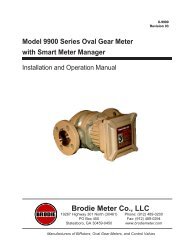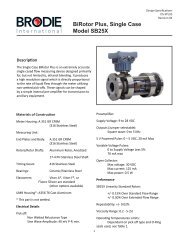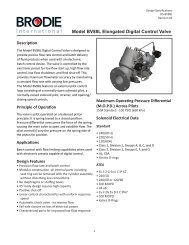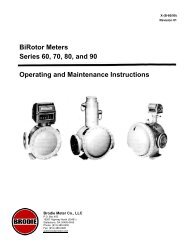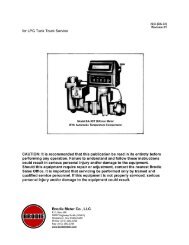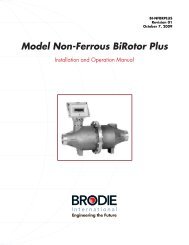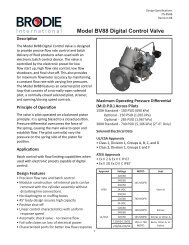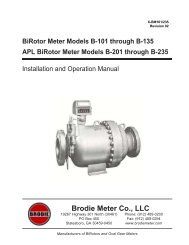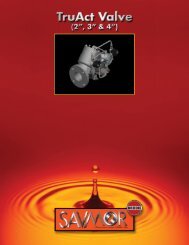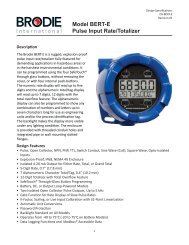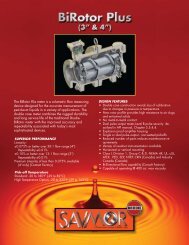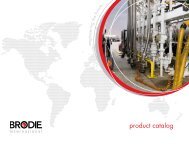9400 Oval Manual - Brodie International
9400 Oval Manual - Brodie International
9400 Oval Manual - Brodie International
Create successful ePaper yourself
Turn your PDF publications into a flip-book with our unique Google optimized e-Paper software.
X-<strong>9400</strong><br />
Revision 01<br />
<strong>Oval</strong> Gear Meter<br />
Model <strong>9400</strong><br />
Installation and Operation <strong>Manual</strong><br />
TM<br />
Engineering the Future<br />
1
2222222<br />
2
Essential Instructions<br />
<strong>Brodie</strong> Meter Co., LLC designs, manufactures and tests its products to meet many national and<br />
international standards. Because these instruments are sophisticated technical products, you must<br />
properly install, use and maintain them to ensure they continue to operate within their normal<br />
specifications. The following instructions must be adhered to and integrated into your safety program<br />
when installing, using and maintaining <strong>Brodie</strong> Meter Co., LLC products.<br />
• Read all instructions prior to installing, operating, and servicing the product. If this instruction<br />
manual is not the correct manual, telephone 1-912-489-0200 and the requested manual will be<br />
provided. Save this instruction manual for future reference.<br />
• If you do not understand any of the instructions, contact your <strong>Brodie</strong> representative for clarification.<br />
• Follow all warnings, cautions, and instructions marked on and supplied with the product.<br />
• Inform and educate your personnel in the proper installation, operation, and maintenance of the<br />
product.<br />
• Install your equipment as specified in the installation instructions of the appropriate instruction<br />
manual and per applicable local and national codes. Connect all products to the proper electrical<br />
and pressure sources.<br />
• To ensure proper performance, use qualified personnel to install, operate, update, program, and<br />
maintain the product.<br />
• When replacement parts are required, ensure that qualified people use replacement parts<br />
specified by the manufacturer. Unauthorized parts and procedures can affect the product’s<br />
performance and place the safe operation of your process at risk. Look-alike substitutions may<br />
result in fire, electrical hazards, or improper operation.<br />
• Ensure that all equipment doors are closed and protective covers are in place, except when<br />
maintenance is being performed by qualified persons, to prevent electrical shock and personal<br />
injury.<br />
• Before opening the flameproof enclosure in a flammable atmosphere, the electrical circuits must be<br />
interrupted.<br />
• The ATEX approval applies to equipment without cable glands. When mounting the flameproof<br />
enclosure in a hazardous area, only flameproof cable glands certified to EN 50018 must be used.<br />
• If replacement of screws that secure the gear housing, sensor housing, UMB, cover, or electric<br />
register is necessary, they must be replaced with M6-1 X 16 mm hex socket head cap screws.<br />
The screws must be made of 304 stainless steel and have a minimum tensile strength of 125 KSI.<br />
• When installing this equipment, bolting must conform to the requirements of ASME B16.5<br />
paragraph 5.3 and to the material requirements of ASME B16.5 Table 1B. Gaskets must conform<br />
to the requirements of ASME B16.20.<br />
• It is the customer’s responsibility to ensure that ipiping or other attachments connected to the<br />
BiRotor Meter do not place adverse stresses on the BiRotor Meter. The design of the BiRotor<br />
Meter has not been assessed for the effects of traffic, wind or earthquake loading.<br />
• It is the customer’s responsibility to provide fire prevention measures and equipment per local<br />
regulations.<br />
• The <strong>Oval</strong> Meter has been designed without allowance for corrosion. The customer should<br />
implement a periodic inspection and maintenance program to ensure that no part of the <strong>Oval</strong><br />
Meter’s pressure-retaining components has been subjected to corrosion.<br />
• Use of this equipment for any purpose other than its intended purpose may result in property<br />
damage and/or serious personal injury or death.<br />
i
Warning<br />
Do not exceed the maximum working pressure of equpment as stamped on the<br />
nameplates. It is the customer’s responsibility to install this equipment in a system that<br />
provides adequate over-pressure protection.<br />
NOTICE<br />
Lines should be flushed thoroughly to rid piping of potentially damaging foreign material<br />
such as welding bead, pipe scale, etc. before the equipment is placed in service. A strainer<br />
of proper size should be installed upstream of the valve to protect it from the introduction<br />
of foreign material.<br />
Notice<br />
<strong>Brodie</strong> Meter Co., LLC (“<strong>Brodie</strong>”) shall not be liable for technical or editorial errors in this manual or omissions from this<br />
manual. <strong>Brodie</strong> makes no warranties, express or implied, including the implied warranties of merchantability<br />
and fitness for a particular purpose with respect to this manual and, in no event, shall <strong>Brodie</strong> be liable for any<br />
special or consequential damages including, but not limited to, loss of production, loss of profits, etc.<br />
Product names used herein are for manufacturer or supplier identification only and may be trademarks/<br />
registered trademarks of these companies.<br />
The contents of this publication are presented for informational purposes only, and while every effort has been made to<br />
ensure their accuracy, they are not to be construed as warranties or guarantees, expressed or implied, regarding the<br />
products or services described herein or their use or applicability. We reserve the right to modify or improve the<br />
designs or specifications of such products at any time.<br />
<strong>Brodie</strong> does not assume responsibility for the selection, use or maintenance of any product. Responsibility for proper<br />
selection, use and maintenance of any <strong>Brodie</strong> product remains solely with the purchaser and end-user.<br />
<strong>Brodie</strong> Meter Co., LLC<br />
Statesboro, Georgia, USA<br />
All rights reserved. No part of this work may be reproduced or copied in any form or by any means - graphic,<br />
electronic or mechanical - without first receiving the written permission of <strong>Brodie</strong> Meter Co., LLC.,<br />
Statesboro, Georgia, U.S.A.<br />
ii
Warranty<br />
1. LIMITED WARRANTY: Subject to the limitations contained in Section 2 herein and except as<br />
otherwise expressly provided herein, <strong>Brodie</strong> Meter Co., LLC (“<strong>Brodie</strong>”) warrants that the firmware<br />
will execute the programming instructions provided by <strong>Brodie</strong>, and that the Goods-manufactured or<br />
Services provided by <strong>Brodie</strong> will be free from defects in materials or workmanship under normal use<br />
and care until the expiration of the applicable warranty period. Goods are warranted for twelve (12)<br />
months from the date of initial installation or eighteen (18) months from the date of shipment by<br />
<strong>Brodie</strong>, whichever period expires first. Consumables and Services are warranted for a period of 90<br />
days from the date of shipment or completion of the Services. Products purchased by <strong>Brodie</strong> from a<br />
third party for resale to Buyer (“Resale Products”) shall carry only the warranty extended by the<br />
original manufacturer. Buyer agrees that <strong>Brodie</strong> has no liability for Resale Products beyond making<br />
a reasonable commercial effort to arrange for procurement and shipping of the Resale Products. If<br />
Buyer discovers any warranty defects and notifies <strong>Brodie</strong> thereof in writing during the applicable<br />
warranty period, <strong>Brodie</strong> shall, at its option, promptly correct any errors that are found by <strong>Brodie</strong> in<br />
the firmware or Services, or repair or replace F.O.B. point of manufacture that portion of the Goods<br />
or firmware found by <strong>Brodie</strong> to be defective, or refund the purchase price of the defective portion of<br />
the Goods/Services. All replacements or repairs necessitated by inadequate maintenance, normal<br />
wear and usage, unsuitable power sources, unsuitable environmental conditions, accident, misuse,<br />
improper installation, modification, repair, storage or handling, or any other cause not the fault of<br />
<strong>Brodie</strong> are not covered by this limited warranty, and shall be at Buyer’s expense. <strong>Brodie</strong> shall not be<br />
obligated to pay any costs or charges incurred by Buyer or any other party except as may be agreed<br />
upon in writing in advance by an authorized <strong>Brodie</strong> representative. All costs of dismantling,<br />
reinstallation and freight and the time and expenses of <strong>Brodie</strong>’s personnel for site travel and<br />
diagnosis under this warranty clause shall be borne by Buyer unless accepted in writing by <strong>Brodie</strong>.<br />
Goods repaired and parts replaced during the warranty period shall be in warranty for the remainder<br />
of the original warranty period or ninety (90) days, whichever is longer. This limited warranty is the<br />
only warranty made by <strong>Brodie</strong> and can be amended only in a writing signed by an authorized<br />
representative of <strong>Brodie</strong>. Except as otherwise expressly provided in the Agreement, THERE ARE<br />
NO REPRESENTATIONS OR WARRANTIES OF ANY KIND, EXPRESS OR IMPLIED, AS TO<br />
MERCHANTABILITY, FITNESS FOR PARTICULAR PURPOSE, OR ANY OTHER MATTER WITH<br />
RESPECT TO ANY OF THE GOODS OR SERVICES. It is understood that - corrosion or<br />
erosion of materials is not covered by our guarantee.<br />
2. Limitation Of Remedy And Liability: <strong>Brodie</strong> Shall Not Be Liable For Damages Caused By Delay<br />
In Performance. The Sole And Exclusive Remedy For Breach Of Warranty Hereunder Shall Be<br />
Limited To Repair, Correction, Replacement Or iii Refund Of Purchase Price Under The Limited<br />
Warranty Clause In Section 1 Herein. In No Event, Regardless Of The Form Of The Claim Or Cause<br />
Of Action (Whether Based In Contract, Infringement, Negligence, Strict Liability, Other Tort Or<br />
Otherwise), Shall <strong>Brodie</strong>’s Liability To Buyer And/Or Its Customers Exceed The Price To Buyer Of<br />
The Specific Goods Manufactured Or Services Provided By <strong>Brodie</strong> Giving Rise To The Claim Or<br />
Cause Of Action. Buyer Agrees That In No Event Shall <strong>Brodie</strong>’s Liability To Buyer And/Or Its<br />
Customers Extend To Include Incidental, Consequential Or Punitive Damages. The Term<br />
“Consequential Damages” Shall Include, But Not Be Limited To, Loss Of Anticipated Profits, Loss Of<br />
Use, Loss Of Revenue And Cost Of Capital.<br />
iii
<strong>9400</strong><br />
CODE<br />
2<br />
53<br />
55<br />
56<br />
57<br />
59<br />
CODE<br />
F<br />
CODE<br />
B<br />
D<br />
H<br />
CODE<br />
7<br />
CODE<br />
C<br />
D<br />
F<br />
CODE<br />
1<br />
4<br />
5<br />
<strong>Brodie</strong> Meter Three-Piece <strong>Oval</strong> Flowmeter Model Number System<br />
The model number consists of 12 numbers as designated in the table below. EX: 94 57 F B 7 C 1 A 3 A<br />
BASIC MODEL NUMBER<br />
BASE METER BY SIZE: Includes register adaptor & gear box with fixed adjustor<br />
1/2"<br />
1''<br />
1''<br />
1- 1/2"<br />
2"<br />
3"<br />
REVISION LEVEL<br />
Three Piece Construction<br />
CONNECTION TYPE<br />
150 lb. ANSI RF Carbon Steel Flanges (Std.); Max. Working Pressure 285 psi at 100 F<br />
300 lb. ANSI RF Carbon Steel Flanges (Std.); Max. Working Pressure 740 psi at<br />
150 lb. Tri-clover with 125 reamed inlet and outlet - for CIP (Clean-in-place) food<br />
COUPLING<br />
Magnetic Type 7<br />
HOUSING and COVER MATERIAL<br />
316 Stainless Steel<br />
Carbon Steel<br />
Alloy 20<br />
GEAR MATERIAL.<br />
316 Stainless Steel (Not for use with Alloy 20 Housing and Cover)<br />
316 Stainless Steel (Voidless for Clean-in-place - For Stainless Steel Housing<br />
Alloy 20 (For 20 Housing and Cover only.)<br />
CODE<br />
GEAR ASSEMBLY CONSTRUCTION<br />
BEARING MAGNET SHAFTS<br />
A Carbon Ceramic Stn. Stl.<br />
B Carbon Ceramic Stn. StI.<br />
C Carbon Ceramic EncaStn. Sti.<br />
L Carbon Ceramic Stn. StI.<br />
M Carbon Ceramic Stn. StI.<br />
R W aukesha Ceramic Chrom. PIt.<br />
T W aukesha Ceramic Chrom. Pit.<br />
(1) Standard Viscosity for products up to 300 centipoise.<br />
(2) High Viscosity for products above 300 centipoise 2<br />
If not noted, gears are Class "A" for process temperatures to 2301F (115C)<br />
2222222<br />
CODE O-RINGS<br />
2 Viton<br />
3 Teflon<br />
7 Silicon (FDA approved for clean-in-place service)<br />
8 EPR<br />
CODE VARIATIONS<br />
A None<br />
B High Temperature to 4001F (204C), Class "C"<br />
E Thermonized Class "A", to 230OF (115F)<br />
F Thermonized Class "C", to 400OF (204C)<br />
R Dual Magnets in Rotor and on Following Shaft<br />
2<br />
TYPE<br />
Std. Viscosity (1)<br />
Std. Viscosity (')Class "C"<br />
Std. Viscosity (1)<br />
High Viscosity (2)<br />
High Viscosity (2) Class "C"<br />
Std. Viscosity 0)<br />
Hiqh Viscosity (2)<br />
Gears noted Class "C" are for process temperatures to 400F (204C).
1.0 <strong>Oval</strong> Flowmeter Series <strong>9400</strong><br />
1.1 Purpose<br />
<strong>Brodie</strong> Flowmeters, hereafter called flowmeters<br />
are positive displacement meters that accurately<br />
measure liquid flow. Total flow is indicated on a<br />
totalizing type register and, through the use of<br />
accessories, provides pulse and rate outputs.<br />
1.2 Description<br />
Flowmeters are of simple and rugged<br />
construction. Precision machined oval-shaped<br />
rotors are used as metering elements which<br />
ensure minimum slippage, high accuracy and<br />
virtual immunity to changes in viscosity.<br />
1.3 Specifications<br />
The following specifications apply to all<br />
Flowmeters. Where there is a difference<br />
between models, it will be so noted.<br />
Pressure Ratings: See Table 1.2<br />
Minimum Operating Temperature<br />
0°F. (-18°C.). Lower temperature is possible.<br />
Consult factory.<br />
Performance<br />
Accuracy: ± 0.5% on viscosities from 0.2 to 5<br />
centipoise and Class C.<br />
± 0.25% for viscosities of 5 centipoise and above<br />
Repeatability: ±0.05%<br />
Accuracy and Pressure Drop Curves: See Fig.<br />
1-1 Capacities: See Table 1-4<br />
Dimensions: See Figure 1.2<br />
Strainer Specifications: See Table 1.3<br />
Table 1.1 Materials of Construction<br />
Housing Rotors Shafts Bushings O-rings<br />
316 316 316 Hard<br />
Viton<br />
Stn. Stl. Stn. Stl. Stn. Stl. Carbon<br />
Warning<br />
Do not use this meter in excess of these<br />
specified values. Failure to stay within values<br />
may result in personal injury and/or damage to<br />
the equipment.<br />
1.4 Materials of Construction<br />
See Table 1.1<br />
Maximum Safe Working Temperature<br />
For standard “Class A” construction 230°F<br />
(110°C) For higher temperatures, special<br />
clearance rotors, high temperature magnetic<br />
follower and register extension are required.<br />
Meters are available with optional high<br />
temperature trim for ”Class C” construction 230°<br />
to 392°F (110° to 200° C). For high temperature<br />
trim, use all stainless steel meters.<br />
3<br />
Note: Available for Models 9402, 9453, 9455 and 9456<br />
only. (316 Stainless Steel is alloy CF-8M Stainless Steel)<br />
Table 1.2 Pressure Ratings<br />
Materials of ANSI Conn. Pressure Rating<br />
Construction Flange at 100°F (38°C.)<br />
Steel 150 RF 285 1965<br />
Steel 300 RF 740 5102<br />
316 Stn. Steel 150 RF 275 1895<br />
316 Stn. Steel 300 RF 720 4960<br />
Table 1.3 Strainer Specifications<br />
Connection Model<br />
Size Number<br />
Mesh Microns<br />
1"& 1-1/2" 9455 & 9456 60 250<br />
2" & 3" 9457 & 9459 40 350<br />
1/2" & 1 " 9402 & 9453 80 150<br />
3
Table 1.4 Flowrange<br />
Capacities (USGPM) Refer to Tech Bulletin T-067 for comprehensive flow data<br />
Conn.<br />
Size Model Cold Hot Water LPG Gasoline Kerosene Light Oil Heavy Oil<br />
(in.) No. Water 140-230T. 0.2 cP 0.3-0.7 cP 0.7-1.8 cP 2-4 cP 5-300 cP<br />
1/2 9402 1.3-6.6 1.8-4.4 3.1-7.9 1.8-7.9 1.3-7.9 0.7-8.8 0.4-8.8<br />
1 9453 2.7-13.2 3.1-8.8 4.8-15.9 3.1-15.9 2.4-15.9 1.2-17.6 0.7-17.6<br />
1 9455 4.4-30.8 5.3-22 7.9-37.4 5.3-37.4 4.4-37.4 1.8-44 1.1-44<br />
1 1/2 9456 8.8-61.6 11-44 15.4-74.9 11-74.9 8.8-74.9 4-88.1 2.6-88.1<br />
2 9457 17.7-132.1 22-88.1 35.2-154.1 22-154.1 17.6-154.1 8.8-176.1 5.3-176.1<br />
3 9459 35.2-264.2 44-176.1 66-308.2 11-308.2 35.2-308.2 26.4-396.3 17.6-396.3<br />
Note: Intermittent Service, eight to ten hours per day. For continuous service on non-lubricating<br />
products, multiply maximum flow by 0.67. Capacities (Liters/Minute)<br />
Capacities (Liters/Minute)<br />
Conn.<br />
Size Model Cold Hot Water LPG Gasoline Kerosene Light Oil Heavy Oil<br />
(in.) No. Water 140-230T. 0.2 cP 0.3-0.7 cP 0.7-1.8 cP 2-4 cP 5-300 cP<br />
1/2 9402 5-25 6.7-16.7 11.7-30 6.7-30 5-30 2.6-33.3 1.5-33.3<br />
1 9453 9.2-50 11.7-33.3 18.3-60 11.7-60 9.2-60 4.5-66.7 2.6-66.7<br />
1 9455 16.7-116.7 20-83.3 30-141.7 20-141.7 16.7-141.7 6.7-166.7 4.3-166.7<br />
1-1/2 9456 33.3-233.3 41.7-167 58.3-283.3 41.7-283.3 33.3-283.3 15-33.3 10-333.3<br />
2 9457 66.7-500 83.3-333.3 133.3-583.3 83.3-583.3 66.7-583.3 33.3-66.7 20-666.7<br />
3 9459 133.3-1000 166.7-666.7 250-1166.7 166.7-1166.7 133.3-1166.7 100-1500 66.7-1500<br />
Figure 1.1 Characteristics Accuracy and Pressure Drop Curves<br />
4<br />
4444444<br />
4
Figure 1.2 Dimensions for <strong>9400</strong> Models<br />
Table 1.5 Dimensions<br />
DIMENSIONS<br />
STRAINER SHIPPING SHIPPING<br />
MODEL A B C D Mesh Microns WEIGHT CUBE<br />
Inches mm Inches mm Inches mm Inches mm Size Approx. lbs. kilo. Ft3 M3<br />
5<br />
9402 12-1/16 307 1-1/4 31 4-13/16 222 4-13/16 122 80 150 33 14.97 1.58 0.045<br />
9453 13 330 1-11/16 43 4-13/16 222 4-13/16 122 80 150 48 21.77 1.81 0.051<br />
9455 13-5/8 347 2 51 6 222 6 152 60 250 64 29.03 1.93 0.054<br />
9456 14-7/8 378 2-9/16 65 7-1/8 254 7-1/8 181 60 250 79 35.83 2.19 0.062<br />
9457 16-1/4 413 3-1/2 89 9-15/16 349 9-15/16 252 40 350 159 72.12 2.99 0.085<br />
9459 19-1/8 486 4-3/4 121 13-3/4 441 13-3/4 349 40 350 259 117.48 4.84 0.137<br />
(For Certified Dimension Prints, consult factory)<br />
5
2.0 Installation<br />
2.1 General<br />
This section contains the procedures for the<br />
receipt and installation of the flowmeter.<br />
2.2 Receipt of Equipment<br />
When you receive your meter, inspect the<br />
outside of the packing case for damage which<br />
may have been incurred during shipping.<br />
Damage incurred during shipment is the<br />
responsibility of the carrier and is not part of the<br />
factory warranty. If the package is in good<br />
condition, remove the envelope containing the<br />
packing list and carefully remove the meter, and<br />
all components included in the shipment, from<br />
the packing case. Inspect for damaged or<br />
missing parts, referring to the packing list, prior<br />
to discarding the packing material. If items are<br />
missing from your shipment, contact your sales<br />
representative. Your sales order number will be<br />
required.<br />
if the packing case is damaged, notify the local<br />
carrier immediately. If the meter must be<br />
returned to the factory for repair or replacement,<br />
a Returned Materials Report (RMR) must be<br />
included with the meter or components. RMR<br />
forms may be obtained from your sales<br />
Department. In addition to the RMR, a Material<br />
Safety Data Sheet and a Decontamination<br />
Statement must be included with items being<br />
returned to the factory.<br />
A Decontamination Statement is included in the<br />
back of this manual for your convenience.<br />
2.3 Return Shipment<br />
To be able to process return goods quickly and<br />
efficiently, it is IMPORTANT that you provide<br />
essential information. Do not return any 6666666<br />
assembly or part without an “R.M.R.”(Retumed<br />
Materials Report), or a letter which describes the<br />
problem, correction action, if any, to be taken,<br />
and the work that is to be performed at the<br />
factory. R.M.R. forms can be obtained from<br />
<strong>Brodie</strong> Sales Offices or the Service Department,<br />
<strong>Brodie</strong> Meter Co., LLC, P.O. Box 450, Highway<br />
301 N., Statesboro, Georgia, 30459.<br />
Place a copy of either of the above inside the<br />
shipping container and attach it physically to the<br />
material being returned. A copy of your packing<br />
list should be placed inside an envelope and<br />
attached to the outside of the shipping container,<br />
or placed inside the container.<br />
Equipment returned to the factory without proper<br />
documentation will be returned to sender at their<br />
expense.<br />
Ship the container to:<br />
<strong>Brodie</strong> Meter Co., LLC<br />
Product Service Department<br />
19267 Hwy. 301 North<br />
Statesboro, GA 30458<br />
Telephone: 1 912 489 0200<br />
Fax: 912 489 0435<br />
2.4 Recommended Procedures<br />
Prior installation of the meter, the following items<br />
of general information and recommendations<br />
should be considered:<br />
1. On new installations, the lines should be<br />
flushed thoroughly to rid the pipe of welding<br />
bead, pipe scale, etc., before the meter is<br />
placed in service. This can be done by using a<br />
spool piece in place of the meter.<br />
2. The flowmeter must be installed sothe shafts<br />
of the rotors are horizontal, never vertical or<br />
“on end.” (See Figures 2.1, and 3.2.) Severe<br />
damage to components may be the result.<br />
3. A strainer should be installed upstream and<br />
adjacent to the flowmeter to protect it from<br />
foreign matter such as dirt, pipe scale or<br />
welding splatter. Refer to Table 1.3 for strainer<br />
data.<br />
6<br />
4. Valves should be installed to facilitate removal<br />
of the flowmeter and strainer.<br />
5. Install flowmeter on the discharge side of a<br />
pump wherever possible.<br />
6. Remove the protective covering from the<br />
flowmeter flanges before installation.<br />
7. LDR counters can be rotated and secured in<br />
any of eight positions.<br />
6
8. The flowmeter should be installed in an area<br />
that has a clean, dry atmosphere and is<br />
relatively free from excessive vibration.<br />
Figure 2.1 Horizontal and Vertical Installations<br />
2.6 Vertical Installation<br />
(See Figure 2.1)<br />
When the flowmeter is installed in a vertical<br />
pipeline, itis recommended that a by pass line<br />
and three valves be provided as shown in Figure<br />
2 1.<br />
The vertical installation has the advantage of<br />
reducing the amount of pipe scale or foreign<br />
matter than could pass through the flowmeter.<br />
The valves permit system start up when the<br />
flowmeter is used with high temperature liquids.<br />
The valves also protect the flow meter frorn initial<br />
flow surges that could damage flowmeter<br />
components from thermal shock.<br />
3.0 Operation<br />
3.1 General<br />
2.5 Horizontal Installation<br />
(See Figure 2.1)<br />
When the flowmeter is installed in the main flow7<br />
line it is recommended that a by-pass line and<br />
three valves be provided as shown in Figure 2 1.<br />
The by pass permits removal of the flowmeter<br />
and cleaning of the strainer without shutting down<br />
the system. Three valves are required as shown<br />
in Figure 2 1. The valves permit system start up<br />
when the flowmeter is used with high<br />
temperature liquids. The valves also control<br />
initial flow surges that could damage flowmeter<br />
components.This is especially important during<br />
start up when the lines are filled with air. Over<br />
speeding and/or running the flowmeter without<br />
liquid lubrication will damage flowmeter<br />
components.<br />
The flowmeter has been completely assembled,<br />
checked and calibrated at the factory. Under<br />
normal circumstances, no adjustments should<br />
be required. Since the flowmeter is calibrated as<br />
a complete unit, it is normal for the register to<br />
indicate other than zero. Do not attempt to start<br />
the system until the flowmeter has been<br />
permanently installed. It is extremely important<br />
that the start up procedures be followed in the<br />
exact sequence presented. Permanent damage<br />
to the flowmeter components may result unless<br />
the procedures are followed.<br />
3.2 Principle of Operation<br />
See Figure 3.1 and 3.2<br />
The <strong>Oval</strong> Flowmeter accurately measures liquid<br />
flow by using a slight pressure differential to<br />
rotate a pair of oval gears. The meshed gears<br />
seal the inlet from he outlet flow, developing the<br />
pressure differential. When in the position shown<br />
in Figure 3 1, Diagram 1, all of the driving torque<br />
resulting from the differential pressure is applied<br />
to Gear A. Gear B has zero driving torque since<br />
equal areas of gear surface on opposite sides of<br />
the axis of rotation are exposed to the higher inlet<br />
pressure. As the gears begin to rotate (see<br />
Diagram 2), the torque applied to Gear A<br />
decreases, but Gear B now has driving torque,<br />
7
due to the increased area exposed to the high<br />
pressure. At the position shown in Diagram 3, all<br />
of the driving torque is exerted on Gear B and<br />
Gear A has decreased to zero. This alternate<br />
driving action provides a smooth rotation of<br />
almost constant torque without dead spots.<br />
Diagrams 4 through 9 illustrate this principle<br />
through a complete cycle bringing Gear A back<br />
to its original position.<br />
As the gears rotate, they trap precise quantities<br />
of liquid in the crescent shaped gaps of the<br />
measuring chamber. The total quantity of flow for<br />
one rotation of the pair of oval gears is four times<br />
that of the crescent shaped gap. The rate of flow<br />
is proportional to the rotational speed of the<br />
gears. Because the amount of slippage between<br />
the oval gears and the measuring chamber wall<br />
is minimal, the meter is essentially unaffected by<br />
changes in viscosity and lubricity of the liquids.<br />
An output shaft is rotated in direct proportion to<br />
the oval gears by means of a powerful magnetic<br />
coupling. The output shaft drives a gear train<br />
that provides meter registration in engineering<br />
units of gallons, liters, pounds, etc.<br />
Figure 3.2<br />
<strong>Oval</strong> Gear Flowmeter, Pictorial Diagram<br />
3.3 Pre Operation Procedure<br />
After the flowmeter has* been installed as<br />
described in Section 2, slowly allow the liquid to<br />
flow in the by pass section of a horizontal<br />
installation or the main line of a vertical<br />
installation. This will clear the line of any foreign<br />
particles.<br />
Caution must be taken so that flow rate,<br />
pressure and temperature are within<br />
recommended specifications. When the<br />
flowmeter is used with high temperature liquids,<br />
refer to special start up procedures in Paragraph<br />
3 5. No other special operating procedures need<br />
to be observed, except to insure the metered<br />
liquid is clear of foreign particles which may<br />
damage the flowmeter.<br />
3.4 Normal Start Up Procedure<br />
After the lines have been cleared, proceed as<br />
follows:<br />
a. SLOWLY open the inlet valve.<br />
b. SLOWLY open the outlet valve.<br />
c. Completely close the by pass valve.<br />
d. Make sure that temperature, pressure and<br />
flow rate are within the recommended<br />
specifications.<br />
3.5 Higher Temperature Start Up Procedure<br />
On temperature service above 150 0 F. (based on<br />
ambient temperature of 70 0 F.), special start up<br />
procedures are required to prevent permanent<br />
damage to flowmeter components. The following<br />
equation may be used to determine the<br />
approximate flowmeter warm up time. A similar<br />
procedure should be followed on any thermal<br />
shock in 8excess of 80F.<br />
8888888<br />
Warm Up Time (Hrs.) = Nom.Conn.Size x (Oper. Temp. 0 F. 150)<br />
100<br />
Figure 3.1 Principle of Operation<br />
8
a. Valve No. 1 and Valve No. 2 must be tightly<br />
closed.<br />
Figure 3.3 High Temperature Installation<br />
b. Valve No. 3 should be opened in gradual<br />
steps until by-pass piping is stabilized at<br />
operating temperature and valve is fully open.<br />
c. With Valve No. 3 open and Valve No. 2 closed,<br />
very a slightly open Valve No. 1. Allow<br />
temperature to stabilize around the flowmeter.<br />
Open Valve No. 1.<br />
d. Open Valve No. 2 approximately 5%, just<br />
slightly admitting flow through the flowmeter.<br />
Caution<br />
If flowmeter rotors bind or make excessive<br />
noise at this time, DO NOT change valve<br />
positions. When temperature has fully stabilized<br />
within the flowmeter, normal operation will<br />
occur. Do not open Valve No.2 any further until<br />
flowmeter rotors are turning freely.<br />
e. With the flowmeter rotors operating normally,<br />
gradually open Valve No. 2 in small<br />
increments until the valve is fully open.<br />
f. Gradually close Valve No. 3.<br />
NOTE: The above procedure must be<br />
followed each time the flowmeter is started<br />
from ambient to operating temperatures<br />
above 150 0 F.<br />
9<br />
3.6 Flowrate Determination<br />
The flowrate may be determined without the use<br />
of test equipment. A stopwatch is the only aid<br />
required. The stopwatch is used to determine<br />
the elapsed time of a predetermined number of<br />
register pointer revolutions. The elapsed time<br />
should be sixty (60) seconds or more and the<br />
minimum number of register pointer revolutions<br />
should be three (3). A minimum of three runs<br />
should be made for greater accuracy. Using the<br />
following information as an example, solve the<br />
equation to derive actual flowrate.<br />
a. Flowmeter maximum flowrate = 32 gpm<br />
b. Register pointer revolutions = 3<br />
c. Register Graduations = 1 revolution equals ten<br />
gallons<br />
d. Indicated Volume = 30 gallons<br />
e. Elapsed Time = 81.8 seconds<br />
IF: Flowrate (Gal./Min.) =<br />
Indicated Volume (Gal.) x 60 Sec./Min<br />
Elapsed Time (Sec.)<br />
THEN: Flowrate (Gal./Min.) =<br />
30 Gallons x 60 (Sec./Min.)<br />
81.8 (Sec.)<br />
OR: Flowrate = 22 gpm<br />
3.7 Accuracy Adjustor<br />
Accuracy adjustment can be accomplished by<br />
using one of two methods. The standard<br />
accuracy adjustor is a fixed gear train in the new<br />
gear box. For calibration purposes, the fixed gear<br />
train can be easily removed for substitution of a<br />
different fixed gear train. In addition to the<br />
standard adjustor, an optional Model 4200<br />
Adjustor is necessary for applications where<br />
various viscosity products will be measured<br />
through one meter or for fine adjustment.<br />
3.8 Accessories<br />
The <strong>Oval</strong> Meter may be mounted to the complete<br />
<strong>Brodie</strong> Meter line of accessories with the design<br />
of the new oval gear box. Reference Page 18 for<br />
the typical accessory combinations that may be<br />
applicable to your meter.<br />
9
4.0 Maintenance<br />
4.1 General<br />
No routine maintenance, cleaning or lubrication<br />
is required on the flowmeter. The user should<br />
establish a schedule for periodic checking and<br />
cleaning of the strainer.<br />
4.2 Manufacturer’s Maintenance<br />
Recommendations<br />
The following items apply to all flowmeters.<br />
Users must give careful consideration to the<br />
consequences that may be the result of failure to<br />
follow manufacturer’s recommendations.<br />
a. No attempt should be made by the user to<br />
alter any physical dimension of the flowmeter<br />
or component part.<br />
b. Do not use force to assemble or disassemble<br />
any component of the flowmeter. All<br />
components are machined to exact<br />
tolerances.<br />
c. When an unserviceable flowmeter has been<br />
returned to the factory for rework, it must be<br />
under-stood that in extreme cases it may be<br />
economically impractical to repair the<br />
flowmeter.<br />
d. No attempt should be made by the user to<br />
replace the rotor bearings. Rotors and<br />
bearings are manufactured as a<br />
subassembly and are available as<br />
replacement or spare parts.<br />
3. Disconnect all electrical lines to or from the<br />
meter.<br />
4. CAUTION: If the meter has been used for<br />
corrosive, toxic or other dangerous<br />
liquids, follow the procedures outlined in<br />
Subpart l, Sections 1910.132 through<br />
1910.140 of the Occupational Safety and<br />
Health Standards, Federal Register No.<br />
202-Pt II-1, or subsequent changes<br />
thereto.<br />
5. Reduce the pressure inside the meter to zero<br />
by completely draining that part of the process<br />
line which is isolated with the meter. It is<br />
recommended that product be removed<br />
through the strainer, drain plug or device other<br />
than the meter for this purpose. If pressure<br />
must be reduced through the flowmeter, very<br />
slowly and carefully loosen the hex screws of<br />
the bottom flange (Figure 6-2, Items 6 and 9)<br />
until the meter begins to drain and pressure is<br />
reduced to zero. Refer to CAUTION in<br />
Item 4 above.<br />
6. Drain the flowmeter completely by removing<br />
the bottom flange (Item 6). CAUTION:<br />
Figure 4.1<br />
<strong>Oval</strong> Gear Flowmeter With One Rotor Installed<br />
4.3 Disassembly<br />
Warning<br />
It is not necessary to remove the flow meter<br />
from the pipeline for disassembly. Read the<br />
ENTIRE procedure for disassembly before<br />
making ANY attempt to disassemble the meter.<br />
Serious personal injury or damage 10101010101010<br />
to the meter<br />
can result if it is improperly handled.<br />
10<br />
Figure 4.2<br />
<strong>Oval</strong> Gear Flowmeter With Both Rotors Installed<br />
Before proceeding with any disassembly, be<br />
certain to:<br />
1. Close all valves and isolate the meter from<br />
line pressure or back pressure.<br />
2. If used at elevated temperatures, reduce the<br />
temperature of the meter, including internals, to<br />
ambient.<br />
10
Extreme care should be taken as the<br />
crescent shaped pockets of the measuring<br />
chamber may still contain liquid.<br />
7. Disconnect all tubing and/or wiring from the<br />
meter mounted accessories.<br />
4.4 Procedure<br />
Caution<br />
Never use any gripping tool or any internal<br />
component of the meter assembly. Do not drop<br />
any part of the meter as damage may occur.<br />
The meter is made up of sub-assemblies which<br />
can be serviced independent of the meter.<br />
When disassembling the gear box or removing<br />
the register, avoid breaking the meter apart at the<br />
meter body and register adaptor, as reassembly<br />
requires the gear box to be separated from the<br />
register adaptor and an involved meshing of the<br />
idler gear with the output gear. Changing the<br />
register DOES NOT require the meter to be<br />
disassembled.<br />
The meter can be disassembled in the line as<br />
well as removed from the line with access to the<br />
bottom flange (Item 6). Utilizing the two jack<br />
screw locations on the face of the flange, insert<br />
cap screws finger tight and turn alternately onehalf<br />
turn to lift the flange from the meter body.<br />
Note: Some models may have slotted<br />
depressions for the flange removal. In such a 11<br />
case, gently pry the flange from the face of the<br />
meter body using an appropriate prying tool.<br />
Caution<br />
When utilizing the prying method, care should<br />
be taken not to score the face of the flange or<br />
meter or to damage the sealing O-Ring.<br />
3. Normally, upon removal of the bottom flange,<br />
the dowel pins (Item 4) and rotor shafts (Item<br />
32) will remain intact with the meter body.<br />
Note position of all components.<br />
4. DO NOT remove <strong>Oval</strong> Gear Rotors (Item 5)<br />
from their shafts unless necessary as<br />
placement is critical to timing. If removal or<br />
replacement is required, note timing marks on<br />
the face of each rotor and mark clearly.<br />
5. For complete measuring unit disassembly,<br />
re-move thrust washers (Item 35), oval gears<br />
(Item 5) and rotor shafts (Item 32) using a<br />
gentle rocking motion.<br />
Caution<br />
Never use gripping tools on internal<br />
components of the measuring unit.<br />
6. Inspect all internal parts for damage and wear.<br />
For service or replacement of parts from the<br />
register adaptor side of the meter or to<br />
disassemble or disengage the register and<br />
register adaptor from the meter body (Reference<br />
Figure 6-2):<br />
1. Loosen the three setscrews (Item 26) of the<br />
register adaptor assembly and lift straight out<br />
to disengage gearing. (Models 9453, 9455,<br />
9456, 9457 and 9459.<br />
2. Proceed to the meter for disassembly.<br />
3. Remove cap screws (Item 10) from the<br />
driving rotor flange (Item 12). Remove and<br />
inspect O-Ring (Item 11).<br />
4. The follower magnet shaft (Item 8) may be<br />
removed at this time.<br />
5. Remove hex screws (Item 9) from the top/<br />
front flange (Item 31). Using jack screws or<br />
prying tool (when the meter body is recessed<br />
for flange removal), alternate sides and lift the<br />
end flange away from the meter body.<br />
(Reference Step 2, “Access Through Bottom<br />
Flange.”)<br />
6. For complete measuring unit disassembly,<br />
locate and clearly mark timing marks of the<br />
oval gears. Remove thrust washers (Item 35),<br />
oval gears (Item 5) and rotor shafts (Item 32)<br />
using a gentle rocking motion.<br />
7. Inspect all internal parts for damage or wear.<br />
Register Adaptor Disassembly<br />
11
1. Remove hex screws from gear box assembly<br />
and lift straight out to disengage adaptor<br />
coupling (Item 21).<br />
2. Remove roll pin (Item 20, coupling (Item 21)<br />
and crescent snap ring (Item 22) to dislodge<br />
transmission shaft assembly (item 24) from<br />
adaptor housing (Item 18).<br />
3. To replace idle gear assembly (Item 25),<br />
remove self-locking nut (Item 19), washer<br />
(Item 17), idle shaft spacer (Item 16) and snap<br />
ring (Item 19).<br />
4.5 Reassembly<br />
It is recommended that new O-Rings be installed<br />
following each disassembly to protect integrity of<br />
the meter seal.<br />
1. Orient the meter in such a way as to have the<br />
measuring cavity facing up and out.<br />
2. Press the rotor shafts (Item 32) into the bores<br />
provided in the meter body using a lock-tight<br />
securing compound. Reference Figure 4-3 for<br />
proper Installation of the hollow rotor shaft and<br />
magnetic rotor. The flow arrow indicates the<br />
proper orientation. The open end of the hollow<br />
shaft is to face toward the register output shaft.<br />
3. Install one thrust washer (Item 35) on each<br />
shaft.<br />
5. Place the remaining rotor, having an internal<br />
magnet and one timing mark, on the hollow<br />
rotor shaft with the timing mark facing out in a<br />
horizontal (6 o’clock) position as shown in<br />
Figure 4-2 and 4-3. Check for proper rotor<br />
mesh by turning the rotors one or more<br />
complete revolutions. If the mesh is not<br />
proper, disengage one of the two oval rotors,<br />
rotate one tooth in either direction, re-engage<br />
and check for proper mesh. Continue this<br />
procedure until a proper mesh is established<br />
allowing free-turning rotors for one or more<br />
revolutions.<br />
6. Install the two remaining thrust washers (Item<br />
35), one on each shaft.<br />
7. Place O-Ring (Item 34) into the bottom flange<br />
(Item 6). Lightly lubricate the O-Ring to assist<br />
in assembly.<br />
8. Carefully line up blind holes in the flange face<br />
with the dowel pins in the meter body. Insert<br />
hex screws (Item 9) and alternately draw the<br />
bottom flange onto the dowel pins and flush<br />
with the meter body.<br />
4. Place the rotor (Item 5) with two timing marks<br />
facing out, on the solid rotor shaft (Item 32) in<br />
a vertical position (12 o’clock).<br />
Figure 4.3 Timing Flowmeter Rotors<br />
(view from bottom flange)<br />
Figure 4.4 Rotor Position Check<br />
12<br />
(view from register)<br />
12121212121212<br />
12
Continue for Reassembly of Meter/Register<br />
Adaptor<br />
9. Return the following magnet shaft (Item 8) to<br />
its original position.<br />
10. Replace O-Ring (Item 11).<br />
11. Secure driving rotor flanges (Item 12) to the<br />
face of the top flange using cap screws (Item<br />
10) and replace the output gear assembly<br />
(Item 13) if originally removed.<br />
Table 4.1 Torque Value for End Flanges<br />
Model<br />
Torque Value<br />
9402 23.4 ft.-Ibs.<br />
9453 24 ft.-Ibs.<br />
9455 24 ft.-Ibs.<br />
9456 35 ft.-Ibs.<br />
9457 104 ft.-Ibs.<br />
9459 174 ft.-Ibs.<br />
12. Reassemble register adaptor, as required, by<br />
referencing Items 3, 2 and 1 of the Register/<br />
Adaptor Disassembly procedure outlined<br />
above. Assure that all mechanical connections<br />
are fastened securely.<br />
13. Align gearing to register adaptor and reengage<br />
meter body. Secure in place using set<br />
screws (Item 26).<br />
NOTE: All gear meshes should be lubricated<br />
using a silicone base lubricating grease.<br />
Figure 4.5 Register Adaptor Installation<br />
13<br />
13
5.0 Troubleshooting<br />
5.1 General<br />
The troubleshooting table is presented as an aid<br />
in locating and correcting operational problems<br />
in the meter. The user must understand that<br />
every possible problem could not be listed.<br />
However, the table will provide adequate<br />
information for general field repairs.<br />
5.2 Metering Error<br />
The actual volumetric flowrate of the flowmeter<br />
may be determined in the field by the user. It<br />
must be noted that the accuracy depends on the<br />
type of test equipment and the method of<br />
performing the operation. If an error is noted, the<br />
following conditions may exist:<br />
a. Errors of measurement may be attributed to<br />
air in a pipeline before the flowmeter or<br />
evaporation of highly volatile liquid in the<br />
pipeline. Piping should be evaluated and<br />
redesigned if necessary.<br />
b. Errors in flow measurements caused by<br />
temperature differences between the liquid in<br />
the flowmeter and liquid in the prover. If there<br />
is any difference, it must be converted to a<br />
base temperature.<br />
c. When oil or caustic soda is measured, care<br />
must be exercised in weight conversion or<br />
temperature compensation.<br />
6.0 Parts List<br />
6.1 General<br />
This section contains the necessary parts<br />
required to make up any standard unit that is<br />
covered in this instruction manual. Each parts<br />
list also contains the recommended spare and<br />
replacement parts denoted by an asterisk. For<br />
items that are not listed or require additional<br />
information, consult the factory. When or-dering,<br />
the following information must be furnished:<br />
a. Part number and description<br />
b. Model number of flowmeter<br />
c. Serial number of flowmeter<br />
d. Quantity required<br />
When ordering items of a material orspecial<br />
construc-tion not indicated in the Parts List,<br />
furnish the following information so that the part<br />
number of the item can be determined.<br />
a. Item number and description<br />
b. Specific material of item<br />
c. Model number of flowmeter<br />
d. Serial number of flowmeter<br />
e. Quantity required<br />
Table 5.1Troubleshooting<br />
Symptom Possible Cause Service Required<br />
No Flow through flowmeter or 1. Foreign particles or solidified matter in measuring chamber. 1. Flush chambers with suitable solvent.<br />
high pressure drop is noted. 2. Inoperative rotors. 2. Replace rotors.<br />
Flow but no indication.<br />
1. Inoperative gear box. 1. Replace gear box.<br />
2. Inoperative accuracy adjustor. 14<br />
2. Replace accuracy adjustor.<br />
3. Inoperative register drive assembly. 3. Replace register drive assembly.<br />
1. Leaky by-pass valve. 1. Repair or replace defective valve.<br />
Flowmeter indicates low 2. Worn, chipped or corroded rotors or case. 2. Repair or replace rotors or case.<br />
compared to actual flow. 3. Flow is below specified rate. 3. Increase flow rate.<br />
14141414141414<br />
4. Magnetic coupling shaft assembly slipping or gear train 4. Repair or replace magnetic coupling<br />
intermittently binding.<br />
shaft assembly, rotors shafts.<br />
1. Air in line or in liquid. 1. Purge all air from line or liquid.<br />
Flowmeter indicates high 2. Pulsating flow rate causes erratic electrical pulse outut and 2. Reduce or eliminate pulsating flows.<br />
compared to actual flow. indicates high. 3. Check zero and span adjustment.<br />
3. Remote rate indicator defective. 4. Check transmitter.<br />
14
6.2 Basic Mechanical Registration<br />
Standard accuracy adjustment is accomplished<br />
through the use of the fixed geartrain in the gear<br />
box. The fixed gear train can be easily removed<br />
and an adjustment in accuracy made by<br />
substitution of a different fixed geartrain. In<br />
addition to this, an optional externally-mounted<br />
Model 4200 Adjustor is available for applications<br />
where products of varying viscosity will be<br />
measured through the meter or wherever fine<br />
adjustment of accuracy is desired. See Bulletin<br />
(S) X-4200 for instructions on the Model 4200<br />
Adjustor.<br />
Figure 6.1 “New Gear Box” Conversion<br />
15<br />
15
16<br />
16161616161616<br />
Figure 6.2<br />
Meter Assembly<br />
16
Table 6.1 Three-Piece <strong>Oval</strong> flowmeter Parts List<br />
Item Description 9402 9453 9455 9456 9457 9459 Qty<br />
1* O-Ring CF-37513-216-SUA CF-3758-224-SUA CF-3758-224-SUA CF-37513-224-SUA CF-3758-235-SUA CF-3758-246-SUA 2<br />
2 Split Ring Flange CA-328C-040-HGC CA-330C-040-HGC CA-330C-040-HGC CA-332C-028-HYC CA-333C-047-HYC CA-335C-021-HYC 2<br />
3 Ring Half CF-724J-016-BYA CA-724J-019-BYA CA-724J-019-BYA CA-724J-020-BYA CA-724J-023-BYA CA-724J-022-BYA 4<br />
4 Dowel Pin 1/4" x 1/2" CF-597F-023-ACA CF-597F-023-ACA CF-597F-023-ACA CF-597F-023-ACA CF-597F-024-ACA CF-597F-024-ACA 4<br />
5* <strong>Oval</strong> Gear Set<br />
Standard "A" Carbon CS-381J-009-JYA CS-381 L-012-JYA CS-381 M-056-JYA CS-381 N-060-JYA CS-381 P-062-JYA CS-381 R-006-JYA 1<br />
Standard "C" Carbon CS-381J-017-JYA CS-381 L-020-JYA CS-381 M-068-JYA CS-381 N-070-JYA CS-381 P-072-JYA CS-381 R-015-JYA<br />
High Vise. "A" Carbon CS-381J-012-JYA CS-381 L-014-JYA CS-381 M-059-JYA CS-381 N-063-JYA CS-381 P-065-JYA CS-381 R-009-JYA<br />
High Vise. "C" Carbon CS-381J-018-JYA CS-381 L-079-JYA CS-381 M-071-JYA CS-381N-072-JYA CS-381 P-073-JYA CS-381 R-067-JYA<br />
Standard "A" Waukesha 2 CS-381J-107-AAA CS-381 L-104-RXA CS-381 M-128-RXA CS-381 N-136-RXA CS-381 P-135-RXA CS-381 R-076-RXA<br />
Standard "C" Waukesha 2 CS-381 J-104-RXA C/F C/F C/F C/F C/F<br />
6 Bottom Flange - Stn. Stl. CC-341 A-776-BMT CC-341 A-776-BMT CC-341 A-765-BMT CC-341 A-783-BMT CD-341 A-773-BMT CD-341 A-785-BMT 1<br />
Carbon Stl. CC-341 A-776-DJA CC-341 A-776-DJA CC-341 A-765-DJA CC-341 A-783-DJA CD-341 A-773-DJA CD-341 A-785-DJA<br />
7* Shaft Assem bly - Stn. StI. CS-786Z-890-BMT CS-786Z-895-EMT -786Z-886-BMT CS-786Z-899-BMT CS-786Z-889-BMT CS-786Z-897-BMT 1<br />
Chrom e Plated CS-786Z-904-BMH CS-786Z-905-BMH CS-786Z-906-BMH CS-786Z-907-BMH CS-786Z-908-BMH CS-786Z-909-BMH<br />
8* Following Magnet Assem bly CS-786Z-891-AAA CS-786Z-893-AAA CS-786Z-215-AAA CS-786Z-900-AAA CS-786Z-903-AAA CS-786Z-898-AAA 1<br />
9 Hex Screw 150765 150765 150766 150836 150829 150844 A/R<br />
10 Cap Scew CG-7538-322-ACA CG-7538-322-ACA CG-751A-508-ACA CG-751A-508-ACA CG-751 E-507-ACA CG-753E-508-ACA 3<br />
11 1 O-Ring CF-3758-012-( ) CF-3758-012-( ) CF-3758-111-( ) CF-37513-113-( ) CF-3758-210-( ) CF-3758-213-( ) 1<br />
12 Flange/Driving Rotor CA-341A-666-GMA CA-341 A-666-GMA CA-341 A-174-GMA CA-341A-184-GMA CA-341A-432-GMA CA-341 A-470-GMA 1<br />
13 Output Gear Assem bly CS-381 A-519-AAA CS-381A-519-AAA CS-381 B-236-AAA CS-381 B-236-AAA CS-381 B-237-AAA CS-381 B-237-AAA 1<br />
14 Snap Ring --- --- CF-7248-006-GBA CF-72413-006-GBA CF-7248-006-GBA CF-7248-006-GBA 1<br />
15 Idle Gear Shaft --- --- CA-786Z-440-BMA CA-7862-440-BMA CA-786Z-440-BMA CA-786Z-440-BMA 1<br />
16 Idle Shaft Spacer --- --- CG-810A-114-NCA CG-810A-114-NCA CG-810A-114-NCA CG-81 0A-114-NCA 2<br />
17 FIatWasher --- --- CG-962A-008-AWA CG-962A-008-AWA CG-962A-008-AWA CG-962A-008-AWA 1<br />
18 Adapter Assem bly CC-693Z-083-FG% CC-693Z-083-FG% CC-693A-068-AAA CC-693A-068-AAA CC-693A-069-AAA CC-693A-069-AAA 1<br />
19 Self Locking Nut --- --- CF-5730-053-ACK CF-5730-053-ACK CF-5730-053-ACK CF-5730-053-ACK 1<br />
20 Pin --- --- 153551 153551 153551 153551 1<br />
21 Coupling --- --- CA-21813-067-ADO CA-2188-067-ADO CA-2188-067-ADO CA-2188-067-ADO 1<br />
22 Crescent Ring --- --- CF-7248-103-BQA CF-7248-103-BQA CF-7248-103-BOA CF-7248-103-BOA 1<br />
23 Idle Gear Arm Assem bly --- --- CS-106Z-847-AAA CS-106Z-847-AAA CS-106Z-848-AAA CS-106Z-848-AAA 1<br />
24 Trans. Shaft Assem bly CS-786Z-741-AAA CS-786Z-741-AAA CS-786Z-444-AAA CS-786Z-444-AAA CS-786Z-445-AAA CS-786Z-445-AAA 1<br />
25 Idle Gear Assem bly --- --- CS-381 8-479-LVA CS-381 8-479-LVA CS-381 8-481-LVA CS-381 8-482-LVA 1<br />
26 Set Screw --- CG-756A-502-AWA CG-756E-502-AWA CG-756E-502-AWA CG-756E-502-AWA CG-756E-502-AWA 3<br />
27 Idle Arm Bracket --- --- CA-106Z-842-BBA CA-106Z-842-BBA CA-106Z-843-BBA CA-106Z-843-BBA 1<br />
28 Machine Screw --- --- CG-753A-267-AWA CG-753A-267-AWA CG-753A-267-AWA CG-753A-267-AWA 1<br />
29 Lock Washer --- --- CG-962D-006-AWA CG-962D-006-AWA CG-962D-006-AWA CG-962D-006-AWA 1<br />
30 Stand Off - CA-830D-236-CAA CA-830D-236-CAA CA-830D-284-CAA CA-830D-284-CAA 1<br />
17<br />
31 Flange - Stn. Stl. CC-341 A-777-BMT CC-341 A-774-BMT CC-341 A-768-BMT CC-341 A-781-BMT CD-341 A-771-BMT CD-341 A-787-BMT 1<br />
Carbon Stl. CC-341 A-777-DJA CC-341A-777-DJA CC-341A-768-DJA CC-341 A-781-DJA CD-341A-771-DJA CD-341A-787-DJA<br />
32* Rotor Shaft - Stn. Stl. CA-786Z-055-BMT CA-786Z-133-BMT CA-786Z-71 1-BMT CA-786Z-712-BMT CA-786Z-713-BMT CA-786Z-91 1-BMT 1<br />
Chrom e Plated CA-786Z-1 09-BMH CA-786Z-136-BMH CA-786Z-718-BMH CA-786Z-732-BMH CA-786Z-733-BMH CA-786Z-91 0-BMH<br />
33 Body - Stn. Stl. CC-093C-044-BMT CC-093M-046-BMT CC-093F-072-BMT CD-093G-055-BMT CD-093P-008-BMT CD-093K-025-BMT 1<br />
Carbon Stl. CC-093C-044-DJA CC-093M-046-DJA CC-093F-072-DJA CD-093G-055-DJA CD-093P-008-DJA CD-093K-025-DJA<br />
34* 1 O-Ring CF-3758-236-( ) CF-3758-236-( ) CF-3758-346-( ) CF-37513-354- CF-3758-442-( ) CF-3758-449-( ) 2<br />
35* Thrust Ring - Carbon --- CA-063F-041 -NKA CA-063F-027-NKA CA-063F-030-NKA CA-063F-001 -NKA CA-063F-036-NKA 4<br />
Waukesha --- CA-063F-041 -RWA CA-063F-027-RWA CA-063F-030-RWA CA-063F-001-RWA CA-063F-036-RWA<br />
36 Drive Screw CF-752Z-004-AWA CF-752Z-004-AWA CF-752Z-004-AWA CF-752Z-004-AWA CF-752Z-004-AWA CF-752Z-004-AWA 4<br />
37 Nam e PLate CA-502Z-154-AWA CA-502Z-154-AWA CA-502Z-154-AWA CA-502Z-154-AWA CA-502Z-154-AWA CA-502Z-154-AWA 1<br />
38 Nam e Plate CA-502Z-339-AWA CA-502Z-339-AWA CA-502Z-339-AWA CA-502Z-339-AWA CA-502Z-339-AWA CA-5022-339-AWA 1<br />
39 H ex N ut --- --- --- --- --- --- 4<br />
40 Round Head Screw CG-7538-321-ACA --- --- --- --- --- 3<br />
41 Set Screw CG-756A-502-AWA --- --- --- --- --- 3<br />
* Recommended Spare Parts 1. Additional Suffix ( ) for O-ring/Elastomer Material Viton-QTA, Kalrez, -TTA, Silicon,-TFA, Teflon-QMA, EPR-SYA 2. Consult factory for High Viscosity Waukesha Gear sets<br />
17
Figure 6.3 Gear Box Assembley<br />
Table 6.2 Gear box and Register Adaptor Assembly - Parts List<br />
Item Description 9402 9453 9455 9456 9457 9459<br />
1 Gear Box Assembly<br />
1 U.S.Gallon CS-381Z-399-AAA CS-381Z-409-AAA CS-381Z-345-AAA CS-381Z-369-AAA NIA NIA<br />
10 U:S. Gallons NIA GS-3812-379-AAA CS-381L285-AAA- CS-3812.3.10-AAA CS-384Z-328-AAA. CS-3812-355-AAA<br />
1000 U.S. Gallons NIA NIA NIA NIA CS-381Z-270-AAA CS-381Z-295-AAA<br />
1 Imperial Gallon CS-381Z-394-AAA CS-381Z-404-AAA CS-381Z-340-AAA CS-381Z-360-AAA NIA NIA<br />
10 Imperial Gallons NIA CS-381Z-374-AAA CS-381Z-280-AAA CS-381Z-300-AAA CS-381Z-320-AAA CS-381Z-350-AAA<br />
100 Imperial Gallons NIA N/A NIA NIA CS-381Z-263-AAA CS-381Z-290-AAA<br />
10 Liters CS-381Z-384-AAA CS-381Z-389-AAA CS-381Z-315-AAA CS-381Z-335-AAA CS-381Z-365-AAA N/A<br />
100 Liters N/A NIA CS-381Z-258-AAA CS-381Z-275-AAA CS-381Z-305-AAA CS-381Z-325-AAA<br />
1000 Liters NIA N/A NIA NIA N/A CS-381Z-269-AAA<br />
A Gear Box Housing CD-441C-291-FD3 CD-441C-291-FD3 CD-441C-291-FD3 CD-441C-291-FD3 CD-441C-291-FD3 CD-441 C-291-FD3<br />
B<br />
Gear Train<br />
1 U.S.Gallon CS-381A-502-AAA CS-381A-512-AAA CS-381A-448-AAA CS-381A-472-AAA NIA NIA<br />
10 U.S. Gallons N/A CS-381A-482-AAA CS-381A-388-AAA CS-381A-413-AAA CS-381A-431-AAA CS-381A-458-AAA<br />
18181818181818<br />
100 U.S. Gallons _NIA NIA N/A NIA CS-381A-373-AAA CS-381A-398-AAA<br />
1 Imperial Gallon CS-381A-497-AAA CS-381A-507-AAA CS-381A-443-AAA CS-381A-463-AAA NIA NIA<br />
10 Imperial Gallons NIA CS-381A-477-AAA CS-381A-383-AAA CS-381A-403-AAA CS-381A-423-AAA CS-381A-453-AAA<br />
100 ImperialGallons NIA_ N/A NIA_ N/A CS-381A-366-AAA CS-381A-393-AAA<br />
10 Liters CS-381A-487-AAA CS-381A-492-AAA CS-381A-418-AAA CS-381A-438-AAA CS-381A-468-AAA NIA<br />
100 Liters N/A N/A CS-381A-361-AAA CS-381A-378-AAA CS-381A-408-AAA CS-381A-428-AAA<br />
1000 Liters NIA NIA NIA NIA NIA CS-381A-372-AAA<br />
C Screw (3) 150632 _150632 150632 150632 150632 0.15<br />
D Cover Plate (1) CA-219Z-146-ENG CA-219Z-146-ENG CA-219Z-146-ENG CA-219Z-146-ENG CA-219Z-146-ENG CA-219Z-146-ENG<br />
E Screw (2) 150529-419 150529-419 150529-419 150529-419 150529-419 150529-419<br />
F Set of 4 Calibration Gears '575-06-3XX-XX '575-06-3XX-XX '575-06-3XX-XX '575-06-3XX-XX '575-06-3XX-XX '575-06-3XX-XX<br />
*Calibration gears vary with individual meters and are installed based upon calibration of the meter. Must substitute “X’s” with part numbers.<br />
18<br />
18
Typical Accessory Schematic for <strong>Brodie</strong> Three-<br />
Piece <strong>Oval</strong> Flowmeters with the new gear box<br />
part Number 381Z-XXX-AAA. All of these<br />
accesories will mount to <strong>Brodie</strong> Three-Piece<br />
<strong>Oval</strong> Flowmeters furnished with the new design<br />
<strong>Oval</strong> Regster/Gear Box.<br />
Notes:<br />
1. Consult factory for torque capability when more than<br />
three accessories are required.<br />
2. When mechanical preset is specified, the quantity<br />
control valve must also be specified.<br />
Figure 6.4 Typical Accessory Schematic<br />
19<br />
19
<strong>Brodie</strong>-<strong>Oval</strong> Meter Registration<br />
Standard-U.S. Gallons<br />
Opional: metric, Pounds, & Barrels<br />
Refer to Tables below for volume per Revolution<br />
of Output shafts, “b” and “C”<br />
(NA=Not Available)<br />
Model #<br />
Output "B" Revolutions/Gal.<br />
The output “B” is exactly one quarter that of output<br />
“A” (the oval gear metering element). Output “C”<br />
is adjusted output that drives the registers in<br />
Engineering Units 1, 10, 100, or 1,000. Due to high<br />
ration, in some models, refer to the chart below<br />
for the volume per revolution pf the output shaft on<br />
each meter model. The gear box can be rotated<br />
for use on meters modified vertically, horizontally,<br />
or diagonally, if the meter rotors remain in<br />
horizontal position.<br />
9402 48.75<br />
9453 27.20<br />
9455 6.775<br />
9456 3.175<br />
9457 1.195<br />
9459 0.4525<br />
Figure 6.5 Output Gearing<br />
20<br />
20202020202020<br />
Output "C" (Units per Revolution)<br />
Model # Meter Size U.S. Gallons Liters Pounds Barrels<br />
Standard Optional Standard Optional Standard Optional Standard Optional<br />
9402 1/2" 1 10 10 100 10 100 0.1 NA<br />
9453 1" 1 10 10 100 10 100 0.1 NA<br />
9455 1" 1 10 10 100 10 100 0.1 NA<br />
9456 1-1/2" 1 10 10 100 10 100 0.1 1<br />
9457 2" 10 100 100 NA 100 1000 1 NA<br />
9459 3" 10 100 100 1000 100 1000 1 10<br />
20
21<br />
21
This page intentionally left blank.<br />
22<br />
22222222222222<br />
22
23<br />
23
This page intentionally left blank.<br />
24<br />
24242424242424<br />
24
TM<br />
Engineering the Future<br />
<strong>Brodie</strong> <strong>International</strong><br />
19267 Highway 301 North • Statesboro, GA 30461<br />
Phone: 001.912.489.0200 • Fax: 001.912.489.0294<br />
A <strong>Brodie</strong> Meter Co., LLC Company<br />
www.brodieintl.com<br />
The contents of this publication are presented for informational purposes only, and while every effort has been made to ensure their accuracy, they are not to<br />
be construed as warranties or guarantees, express or implied, regarding the products or services described herein or their use or applicability. <strong>Brodie</strong> Meter<br />
Co., LLC reserves the right to modify or improve the designs or specifications of such products at any time without notice.



